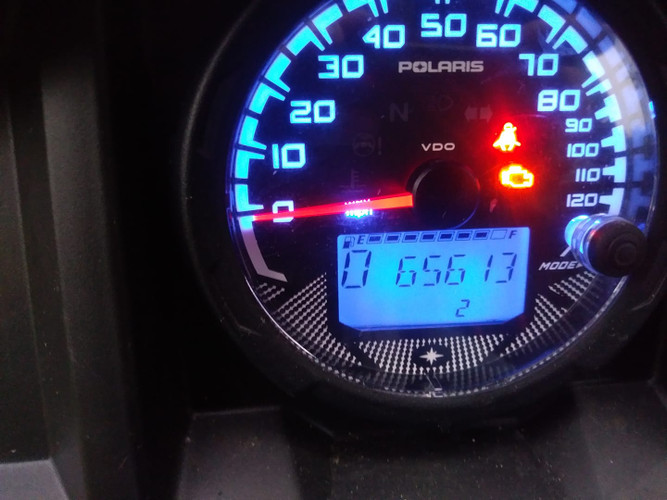A Detailed Walkthrough Of Polaris Ranger Check Engine Lights And Error Codes
Feb 27th 2021

The Polaris Ranger is a complicated machine, and as such, there are countless ways in which side-by-sides like the Ranger Mid-Size, Ranger Full-Size, and Ranger Crew can malfunction. Luckily, most Polaris Ranger editions will flash check-engine lights and error codes on the instrument cluster when things go awry, and these codes indicate which issues might exist and detail where the potential problems may lie. Failure Mode Identifiers (FMIs), for example, are used in conjunction with a Suspected Area of Fault (SPN) to determine electronic problems, whereas Diagnostic Trouble Codes (DTCs) are thrown when on-board sensors detect suspicious inputs. The owner’s manual can be used to decipher the meaning of Polaris Ranger error codes and check engine lights, but if you've lost your manual or never had one to begin with, here is a detailed walkthrough of Polaris Ranger check engine lights and error codes!
Common Polaris Ranger Error Codes

Before you drive yourself crazy trying to diagnose and fix your Polaris Ranger after an error code is thrown, there are a few basic things you should check and rule out first. On most Polaris Ranger model years, thermostats, sensors, and wiring is often to blame for both error codes as well as check engine lights. If your rig doesn’t show the correct gear -- or any gear at all -- on the dash, you’ve probably got a bad gear position sensor. And if the lights on your rig are still on, holding down the menu button and flipping to the diagnostic code page will give you a numbered readout that you can look up for specifics. Error code 656 on a 2015 Ranger 900 XP, for example, typically involves issues with the ETC accelerator position sensor (i.e the gas pedal sensor). If you’ve made sure that the connections are dry, clean, and unbroken, replacing the bad sensor should set you straight.
Polaris Ranger misfire codes are also commonplace, with direct cylinder misfires that activate limp mode and other misfire codes occurring in even new model years with low milage. A temporary fix for Polaris Ranger misfire codes is to shut the vehicle off and then fire it back up again, but this is a short-term solution that won’t remedy the underlying problem. A slipping belt is another usual suspect that causes misfire codes to be thrown, so replacing your belt when a misfire code is displayed will likely lead to a resolution. It's a well-known fact that Polaris made their knock sensor codes over sensitive in the Ranger, and it only takes a single tooth slipping to throw an error code. If the error light doesn’t turn off after you install a new belt, put your Ranger in neutral and rev the engine at 4,000 rpm for a minute or two and see if that works. Alternatively, you can also send your electronic control unit to a place like Gilomen Innovations, which will open up the parameters of the ECU to reduce its sensitivity.
Another error code that the Polaris Ranger frequently throws is code 520207, which indicates that the all wheel drive control circuit is stuck. To release the 4WD, drive your rig at least 10 feet in reverse, put it in neutral, and then move forward in low gear only. If that doesn’t turn the check engine light off, you can also push in the plugs by the front and rear differentials.

Error code 520285 means that you need new brake pads, while error code 520207 sub 5 means that you have a short to ground and need to look at the wire harnesses for rubs, tears, and other forms of damage. Further common Polaris Ranger error codes include 3598 -- which is a code for low output voltage from the ECU that typically indicates a loose wire, a bad connection, or a bad ECU -- 65590 / 65591 misfire codes -- which can often be fixed with new NGK spark plugs -- and 746-5 -- which you might be able to clear by disconnecting the battery, cycling the key a couple times, and then reconnecting the battery. If all else fails when error codes are thrown, plugging in your Ranger to a laptop and clearing the stored error code might be the best course of action.
False Positive Polaris Ranger Error Codes

There are many accounts of Polaris Rangers throwing false positive error codes when no errors actually exist. As long as you’ve kept up with scheduled maintenance and haven’t abused your rig too badly, the likelihood is high that either a sensor is bad or some wiring has come loose. The flashing yellow check engine light on the 2015 Mid-Size Ranger 570, for instance, is the error code for the speed sensor. Although the speed sensor rarely goes bad, the speed sensor wiring often does. So an easy fix for this is to simply get a new plug and then splice it in.
Looking for chaffed wiring when Polaris Ranger error codes appear is a smart thing to do. The Ranger is similar to a modern car or truck, sending a 5V reference signal to the sensors to get feedback about the performance of the various components. If one of the wires is rubbed through and shorted to the ground, it will pull the voltage down for all sensors fed by that circuit. That being said, you should also be sure that the battery voltage is normal -- somewhere around 12V when the engine is off, and between 13V and 14V when the engine is running.
Even if the wires look normal, they can break inside the insulation if the wires coming from the connector bend immediately after entering / exiting said connector. Using a voltmeter is key, and checking to see what’s getting power and what’s not will save you from frustrating and expensive trial-and-error guesswork.
Closing Thoughts

After fixing the underlying cause of your Polaris Ranger error codes and check engine lights, the vehicle should clear the codes automatically. Some codes will clear after you hit 25 mph, while others will clear as soon as you move fast or long enough for the sensor to generate a positive reading. Damaged wiring and bunk sensors are often to blame, with the throttle position sensor (TPS), gas pedal sensor, and knock sensor being particularly problematic. It should also be noted that your wiring / wire harnesses can be broken down to a single strand and still give proper ohms resistance specs, so identifying and diagnosing the underlying problem can be quite difficult at times. But with a lot of perseverance and a little luck, any Polaris Ranger error code / check engine light can be diagnosed and fixed!


